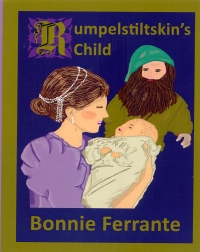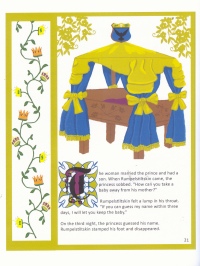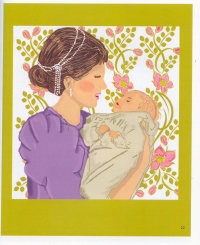| ________________
CM . . .
. Volume XX Number 37. . . .May 23, 2014
excerpt:
“Rumpelstiltskin” was one of the stories collected by the Brothers Grimm and included in their 1812 Children’s and Household Tales. As characters from fairy tales are in the public domain, they can be used by contemporary authors in “new” stories, and that’s what Ferrante has done in Rumpelstiltskin’s Child where she tells of Rumpelstiltskin’s life both before and after the core incidents of the Grimms’ original “Rumpelstiltskin”. As the excerpt above indicates, Rumpelstiltskin’s village neighbours mocked his physical appearance and even called him names. Rumpelstiltskin’s response to this verbal abuse was to isolate himself from the villagers. However, one day, while fishing from a river bank, Rumpelstiltskin sees a boy fall into the river, and he jumps in and pulls him to shore. When Rumpelstiltskin takes the unconscious boy to town, the villagers assume the child is dead and label Rumpelstiltskin as a murderer. A frightened Rumpelstiltskin flees the village and begins a period of wandering. It is during Rumpelstiltskin’s “wilderness” time that he encounters the young woman who needs assistance in spinning straw into gold for a prince. Ferrante then provides a most abbreviated version of the events found in the Grimms’ original tale before having a lonely Rumpelstiltskin decide “it was time to go home.” The response Rumpelstiltskin receives from the villagers is not the one he expects for he is lauded as a hero by the now apologetic villagers who have realized that Rumpelstiltskin actually rescued Tommy, an orphan. Though the village cobbler had taken Tommy in, he already has seven children of his own, and so he suggests to Rumpelstiltskin, “Tommy needs a family,...and you don’t have one.” Rumpelstiltskin agrees, and his home becomes the village’s de facto orphanage. The final page is a “callback” to Rumpelstiltskin’s gold spinning episode.
Design-wise, Ferrante places her text on the left page of each pair of facing Schools and public libraries can take a pass on this fractured fairy tale. Not Recommended. Dave Jenkinson, CM’s editor, lives in Winnipeg, MB.
To comment
on this title or this review, send mail to cm@umanitoba.ca.
Copyright © the Manitoba Library Association. Reproduction for personal
use is permitted only if this copyright notice is maintained. Any
other reproduction is prohibited without permission.
NEXT REVIEW |
TABLE OF CONTENTS FOR THIS ISSUE
- May 23, 2014.
AUTHORS |
TITLES |
MEDIA REVIEWS |
PROFILES |
BACK ISSUES |
SEARCH |
CMARCHIVE |
HOME |

 For me, the logic of the story just didn’t work. The rationale for the villagers’ initial teasing of Rumpelstiltskin isn’t made clear. They have someone who can mine gems and provide food in the form of fish and vegetables, but the villagers simply overlook all of this and only focus on Rumpelstiltskin’s physical appearance. The truncated version of the central tale originally recorded by the Grimms falls flat. Where is the excitement and tension in the following Ferrante passage?
For me, the logic of the story just didn’t work. The rationale for the villagers’ initial teasing of Rumpelstiltskin isn’t made clear. They have someone who can mine gems and provide food in the form of fish and vegetables, but the villagers simply overlook all of this and only focus on Rumpelstiltskin’s physical appearance. The truncated version of the central tale originally recorded by the Grimms falls flat. Where is the excitement and tension in the following Ferrante passage? pages, with the right-hand page carrying a full-page illustration. The text pages are also highly illustrated and resemble pages from an illuminated medieval manuscript. Unfortunately, the excellent quality of the text illustrations does not carry over to the full-page illustrations. In particular, Rumpelstiltskin is inconsistently illustrated, especially in places where he is supposed to be the same age. And, on p. 24, his long beard suddenly disappears with no explanation.
pages, with the right-hand page carrying a full-page illustration. The text pages are also highly illustrated and resemble pages from an illuminated medieval manuscript. Unfortunately, the excellent quality of the text illustrations does not carry over to the full-page illustrations. In particular, Rumpelstiltskin is inconsistently illustrated, especially in places where he is supposed to be the same age. And, on p. 24, his long beard suddenly disappears with no explanation.